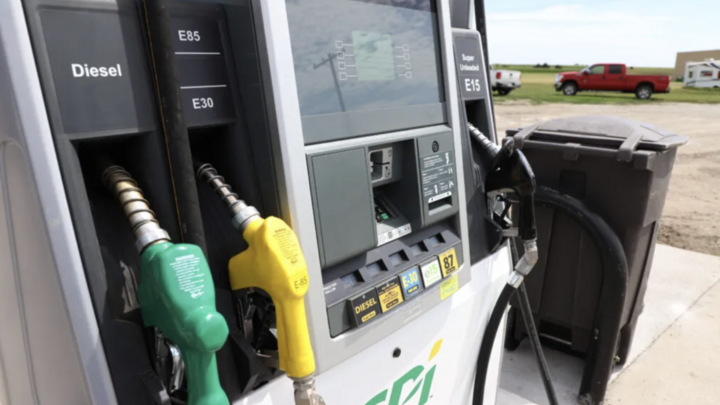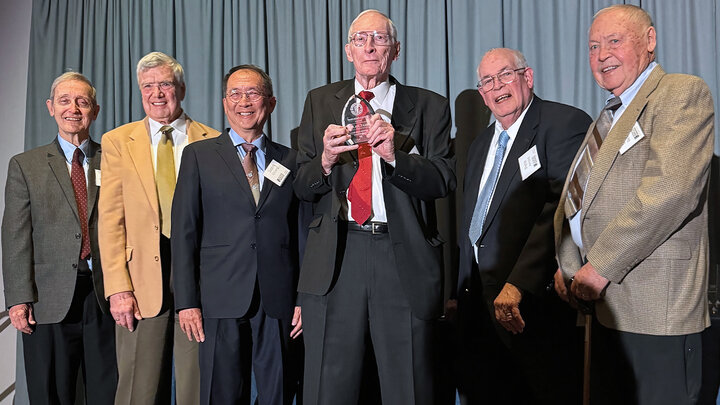What if the key to cleaner, cheaper fuel wasn’t waiting for tomorrow’s technology but was already parked in your driveway?
In 2021, the State of Nebraska rolled out a fleet of 50 vehicles – Dodge Avengers and Chargers and Ford Fusions – for a bold trial, swapping regular gasoline for E30, a 30% ethanol blend.
The goal was to answer a high-stakes question for the future of clean energy: can standard cars run reliably on higher-ethanol fuel without modification?
The wager was simple: if these workhorses within the state motor pool could handle higher-ethanol fuel without trouble, it could change what drivers everywhere put in their tanks.
And, it could have a positive ripple effect throughout the state.

“Nebraska's bioeconomy isn’t abstract, it’s embodied in this study,” said Rajib Saha, Richard L. and Carol S. McNeel Associate Professor of Chemical & Biomolecular Engineering, who led the groundbreaking study alongside graduate researcher Adil Alsiyabi and undergraduate student Seth Stroh. “It’s about corn farmers seeking new markets, rural towns gaining value, and policymakers finally having concrete evidence that small tweaks could yield big wins—for the state, the climate, and the bottom line.
“This project was not the work of an industry lobby or an outside consultant. It began in the Department of Chemical & Biomolecular Engineering at the University of Nebraska-Lincoln, co-funded by the Nebraska Corn Board and the Nebraska Ethanol Board, and it’s indicative of the innovative, practical and high-impact research that has become synonymous with this department.”
Each vehicle was outfitted with onboard diagnostic (OBD) trackers. Over the span of a year, the cars drove the Cornhusker state’s backroads and highways, and the trackers collected millions of data points flowing in like a silent symphony.
The results shattered expectations:
- No observable negative effects on engine performance, despite the higher oxygen content in E30 fuel.
- Fuel efficiency dipped only modestly, but E30’s ~2.5% price advantage made it economically equal, or better.
- A statewide shift from E15 to E30 fuel in fleet vehicles meant 66,000 more gallons of ethanol consumed annually and 529 tons fewer CO₂ emissions.
- If 10 percent of Nebraska’s non-flex-fuel vehicles switched, that would translate into 18.5 million gallons of additional ethanol use and 64,000 fewer tons of CO₂—a genuinely monumental impact.
Within months, local agriculture leaders touted increased fuel purchases. This work was published in a peer-reviewed journal, and ethanol and energy publications called it a breakthrough, according to Saha. The Nebraska Ethanol Board championed the results as proof that E30 could work in everyday vehicles as well.
Saha also noted that it provided empirical evidence that higher ethanol blends could deliver both savings and sustainability through modest MPG changes and big cost savings; no hardware failures or check-engine nightmares; and data-driven environmental benefits tied directly to corn-based ethanol.
The project continues. Phase II launched in 2023, and as of mid‑2025, nearly 94 state vehicles have logged hundreds of thousands of miles on E30—fortifying Phase I’s early findings with broader scope and deeper detail.
“E30 is safe, effective and economically viable,” Saha said. “The results of this project are reinforcing the idea that higher ethanol blends aren’t fringe—they’re practical and scalable.”
The project isn’t just generating data — it’s reshaping how Nebraskans see their own future.
“Nebraska's bioeconomy isn’t abstract – it’s about corn farmers seeking new markets, rural towns gaining value, and policymakers finally having concrete evidence that small tweaks could yield big wins: for the state, the climate, and the bottom line,” Saha said.
“This isn’t just about fuel. It’s about leadership and about a department not asking, ‘could this work?’ but ‘why couldn’t it work?’ This team transformed everyday vehicles into agents of change—bridging cornfields with cutting-edge data science.”
That transformation is being measured not just in ideas, but in miles driven and dollars saved. As part of the core project team, Loren Isom, associate director of the University of Nebraska – Industrial Agricultural Products Center, emphasizes that fuel economy should be viewed through the lens that matters most to drivers: cost per mile. Interim data from the Phase II study confirms that vehicles operating on E30 fuel blends are delivering meaningful savings — with the 2003–2019 vehicle group recording a 20 percent lower operating cost: 16 cents per mile on E30 versus 20 cents on E10.
That kind of evidence is exactly why the Nebraska Ethanol Board (NEB), a key funder of the demonstration, views the effort as more than an experiment — they see it as a breakthrough. “The E30 demonstration is a terrific project for Nebraska,” Nebraska Ethanol Board (NEB) Executive Director Ben Rhodes said. “This is one-of-a-kind research that is adding real value to the state. We’re showing that mid-level blends of homegrown ethanol are safe and effective across the entire US light-duty fleet, as well as demonstrating that E30 is viable under real-world market conditions.”
That viability is already showing up at scale. So far, the State of Nebraska has utilized more than 600,000 gallons of E30 fuel in the demonstration, saving more than $300,000 in fuel costs and adding nearly $400,000 in value to Nebraska’s ethanol producers.
And with about a year still left on the timeline, Rhodes believes the direction is undeniable: “It’s clear that the demonstration is moving in the right direction toward the long-term goal of widespread E30 adoption and use.”




